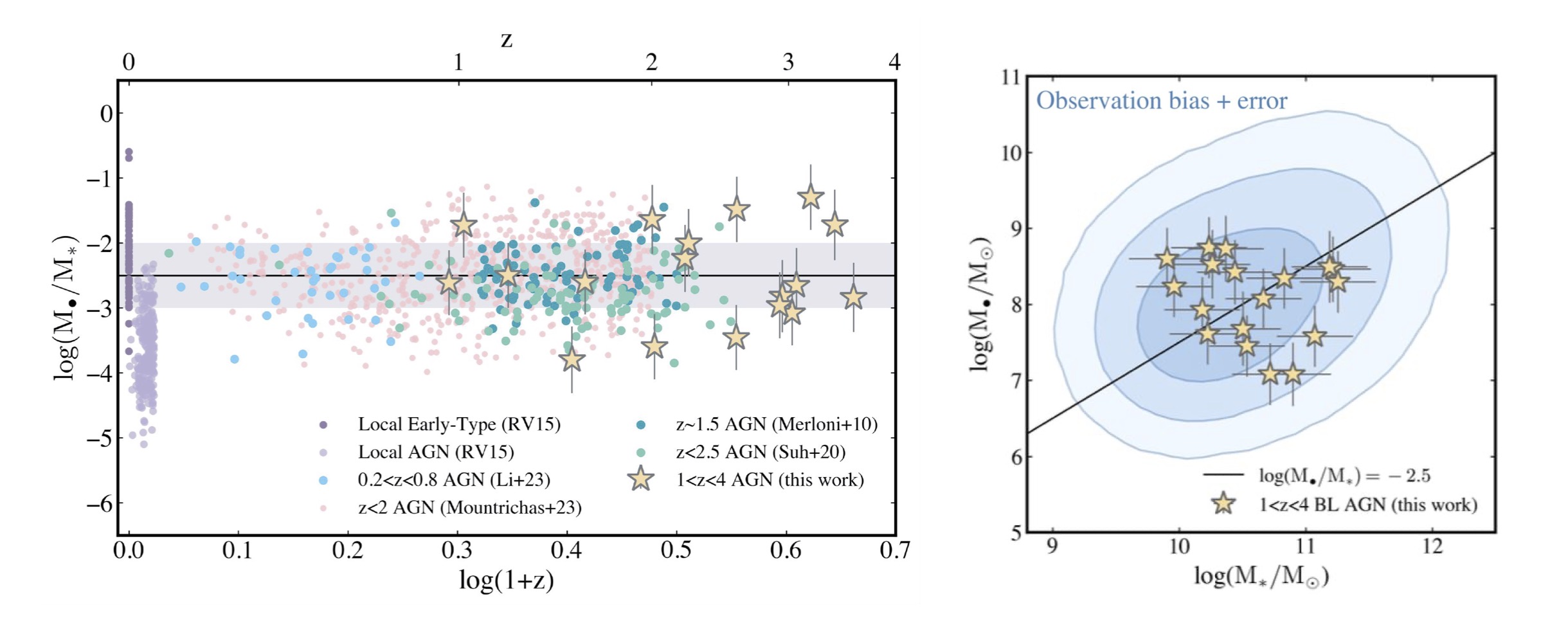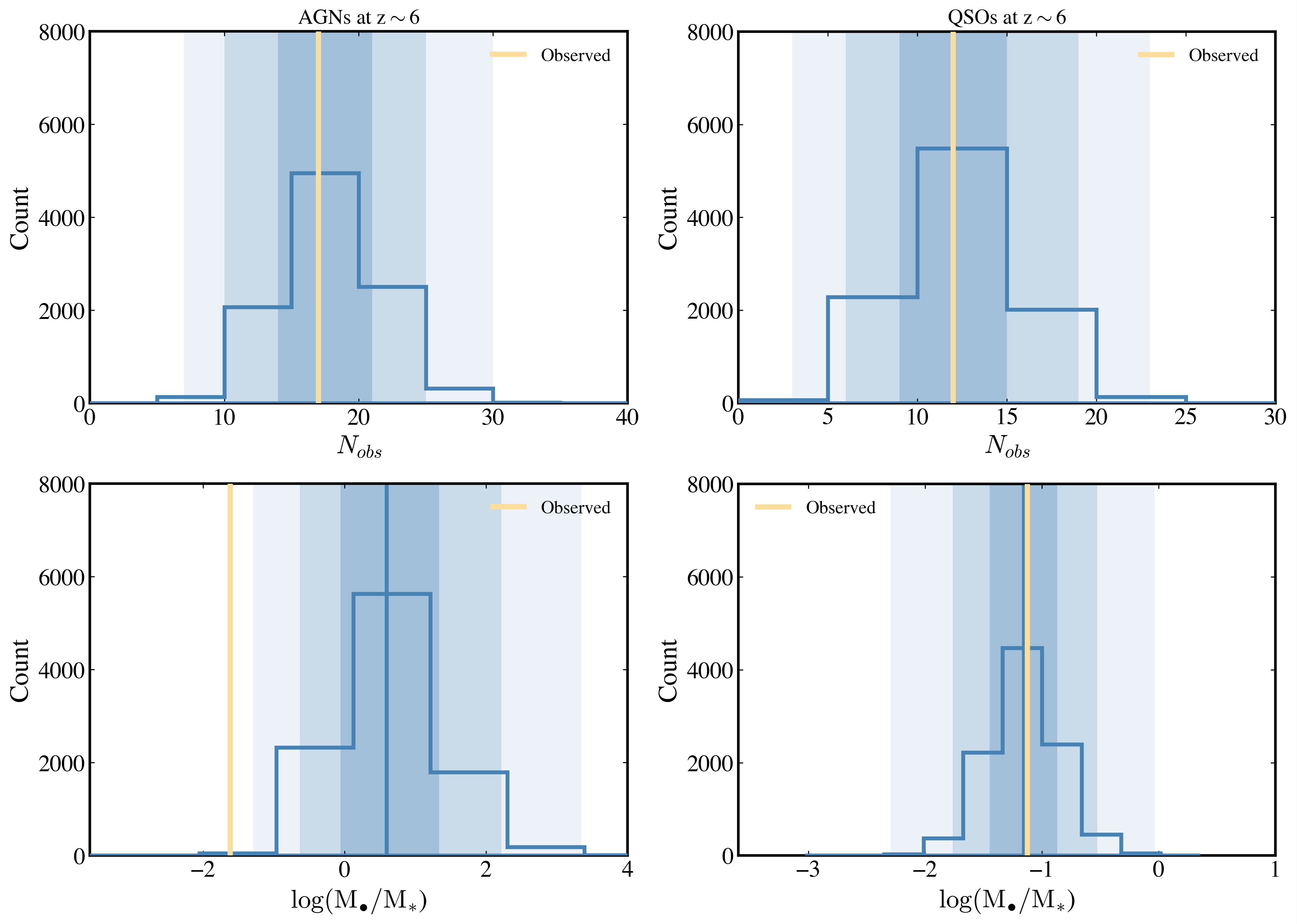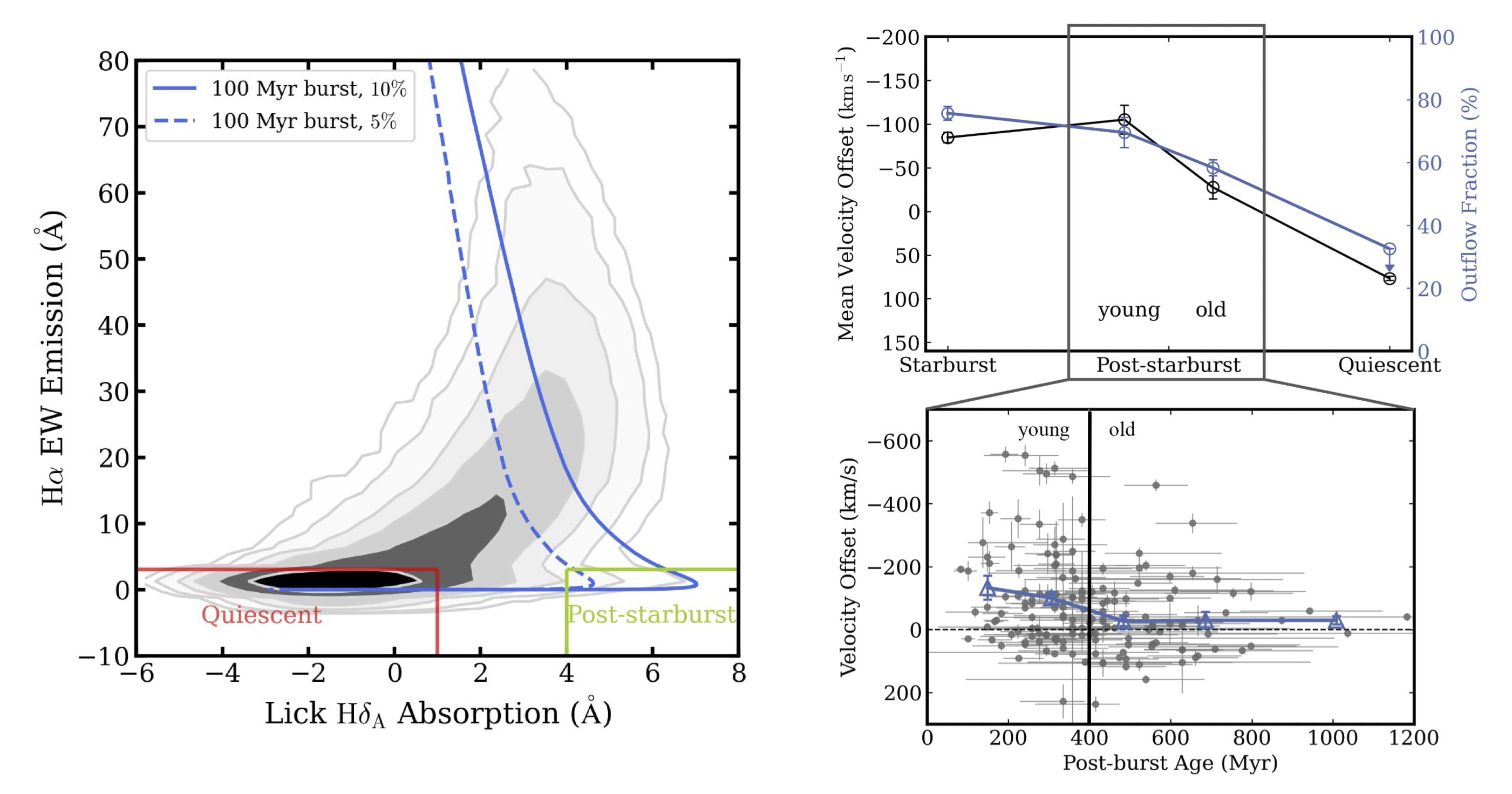Research
Topic 1: Supermassive black hole and galaxy co-evolution across cosmic time
The co-evolution of galaxies and central supermassive black holes (SMBH) has been observationally confirmed by the strong BH mass and host galaxy mass (or central velocity dispersion) correlation in the local Universe and the similar cosmic evolution of star formation rate density and BH accretion rate density up to z~3. My research focus on when and how the SMBH-galaxy co-evolution happens in the early Universe by studying the BH mass-galaxy stellar mass relation at different cosmic epoch.
No Evidence for a Significant Evolution of $M_{BH}$–$M_{*}$ Relation in Massive Galaxies up to $z\sim4$ (Sun et al. 2025a)
With a combination of JWST Near Infrared Camera (NIRCam)/wide field slitless spectroscopy (WFSS) from FRESCO, CONGRESS and deep multiband NIRCam/image data from JADES in the GOODS fields, we extended the study the black-hole-to-galaxy mass relation up to $z\sim4$. After identifying 18 broad-line active galactic nuclei (AGNs) at $1<z<4$ (8 at $z>2.5$) from the WFSS data, we measure their black hole masses based on broad near-infrared lines (Pa$\alpha$, Pa$\beta$, and He I), and constrain their stellar masses from AGN–galaxy image decomposition or spectral energy distribution decomposition. Taking account of the observational biases, the intrinsic scatter of the mass scaling relation, and the errors in mass measurements, we find no significant difference in the black-hole-to-galaxy mass ratio of for $1<z<4$ compared to that at lower redshifts, suggesting no evolution of the mass scaling relation at $\log(M_{*}/M_\odot)>10$ up to $z\sim4$.
Evolution of the $M_{BH}$–$M_{*}$ Relation from $z\sim6$ to the Present Epoch (Sun et al. 2025b)
Recent discovery of high-z ``overmassive’’ AGN by JWST suggests that the mass scaling relation has significant evolution at $z>4$. We test this possibility by (1) determining the preferred mass scaling relation among those proposed locally, and (2) providing uniform estimates of host galaxy stellar mass. These steps reduce the prominence of the reported evolution. We then we applied the same forward-modelling algorithm built in Sun et al. 2025a to account for observational biases. We still find a significant increase over the local scaling relation in black-hole-to-galaxy mass ratio for $z>4$ SMBHs in very low-mass galaxies. However, similarly high values of black-hole-to-galaxy mass ratio are also found in low-mass galaxies at $z\sim0.5–3$, which may be common at cosmic noon. Nonetheless, galaxies with similar behavior are rare locally and not accounted for in the local scaling relations. In contrast, $z\sim6$ quasars can have black-hole-to-galaxy mass ratio well above the value given by the local relation, but they can be explained as extreme cases still within the scaling relation for their higher-mass host galaxies. Black holes in some of them and in the low-mass systems may be undergoing episodes of very high accretion that result in high black-hole-to-galaxy mass ratio but that will be followed by quiescent periods when growth of the host drives the systems toward more typical black-hole-to-galaxy mass ratio values.
Topic 2: How does AGN/SF feedback contribute on galaxy quenching?
AGN feedback has been considered as one of the key physical mechanism linking the growth of SMBH and host galaxy. Moreover, galactic feedback itself, performed as outflows, offers an efficient and fast way to shut down the star formation, transiting blue star-forming galaxies to red dead galaxies. To understand how feedback work on regulating the SMBH and galaxy growth, and galaxy quenching, it’s crucial to study outflows properties along the galaxy evolutionary sequence, espeically at the quenching phase.
Extreme Neutral Outflow in an Inactive Quenching Galaxy at z~1.3 (Sun et al. 2025c)
In this work, we report a substantial sodium doublet (Na D)-traced neutral outflow in a quiescent galaxy JADES-GS-206183 at $z=1.317$ in GOODS-S field. Its JWST NIRSpec/MSA spectrum shows a significantly blueshifted and deep Na D absorption, revealing a neutral outflow with a mass outflow rate exceeds that of any neutral outflows identified previously beyond $z\sim1$ by the same line diagnostic and is comparable with those in local galaxies with intensive star formation or luminous AGN. Surprisingly, JADES-GS-206183’s current star formation rate is relatively low, making it 0.5 dex below the main sequence. However, the best-fit SED modeling of this galaxy, based on its multi-band photometry from HST/ACS to JWST/NIRCam and the VLT/MUSE spectrum, suggests that the host galaxy might just have started to rejuvenate within the recent 10 Myr, after a quiescent period lasting about one Gyr or more. More surprisingly, rest-frame optical lines indicate that the current AGN activity of JADES-GS-206183, if present, is also weak. The results then demonstrate that the Na D outflow in JADES-GS-206183 is highly unlikely to be driven by current rejuvenated star formation or nuclear activity; instead, this outflow may be a long-lasting fossil one driven by past AGN activity, potentially co-triggered with the early phase of rejuvenation.
Evolution of Gas Flows over the Starburst to Post-Starburst to Quiescent Galaxy Sequence (Sun et al. 2024)
Using the SDSS survey, we also built up a potential evoluntionary seuqence in the local universe by selecting starburst, post-starburst, and quiescent galaxies on the H$\delta$ index – H$\alpha$ EW diagram. We measured velocity offsets in the Sodium doublet (Na D) interstellar medium absorption lines to track how neutral galactic winds change as their host galaxies evolve. We detect bulk flows across this sequence, mostly at higher host stellar masses. Along this sequence, the outflow fraction and the mean velocity offset both decrease. Even within the post-starburst sample, wind speed decreases with time elapsed since the starburst ended. These results reveal that outflows diminish as galaxies age. For post-starbursts, there is evidence for an AGN contribution, especially to the speediest outflows.




